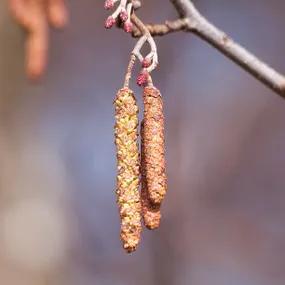Golden Alder, Large Trees
Honest Delivery Prices- Same as Alnus incana, with yellow leaves & pink catkins in spring.
- Ideal for very poor and wet soils
- Fixes nitrogen
- Max. Height: 20m
- Bareroot Delivery: Nov-Mar.
- RHS Award of Garden Merit
Description
Alnus incana Aurea: Golden Alder. Standard Size Trees
The Golden Alder, Alnus incana Aurea, is a beautiful ornamental variety of Grey Alder, smaller and tidier than the wild species, without their strong suckering habit. Its season of interest is mainly spring. The bare branches are decked for about 3 weeks with sumptuous pink catkins in February-March, which provide food for hungry bees. The leaves appear in a verdant display of pale yellow-green that contrasts nicely with the catkins, which keep their pink hue until early summer. In winter, the new, reddish-yellow twigs provide a small touch of colour.
Unlike the wild Alders, Golden Alder is quite slow growing and relatively small, suitable for the average sized garden where it can reach a maximum height of 10 metres, with quite a compact, naturally pyramid/egg shaped canopy, not more than 5 metres wide.
Browse our other alder trees or all our garden trees.
Features:
- Beautiful early spring display of pink catkins
- Very compact and tidy compared to wild alders
- New growth provides a little colour in winter
- Thrives on wet soils with good sun
- Fixes nitrogen
- RHS Award of Garden Merit
Growing Golden Alder
It especially loves wet, even waterlogged sites with heavy soil, but it is extremely hardy and will grow in practically any soil as long as it has plenty of sun. It likes chalk, but is not recommended for rocky sites with shallow topsoil. It is highly pollution tolerant, but won't be happy embedded in a pavement or anywhere with paving slabs around it.
It can grow quite close to the coast where salt winds blow, but it needs deep, rich soil to establish well enough to resist extreme winds.
Note: Alders have invasive roots that can break old water pipes and damage the foundations of old buildings or walls. 15 metres away from vulnerable structures is a safe distance to plant Alder. New build, concrete foundations are not at risk.
Planting Instructions
Notes on planting Golden Alder trees:
Golden Alder trees will grow well in sunny sites and most soils, apart from chalk. They love really wet soil.
They will not grow in the shade. Very dry soil may be a problem, but if you are prepared to water them in summer every year, they will thrive in the most poorly fertile earth.
Prepare your site before planting:
It is good to dig over the site where you plant a tree several months in advance. Kill the weeds first: for tough weeds like nettles, brambles and ground elder, you will usually need a weed-killer to get rid of them. When you dig the soil over, remove stones and other rubbish and mix in well rotted compost or manure down to the depth of about 2 spades.
Watch our video on how to plant a tree for full instructions.
Remember to water establishing trees during dry weather for at least a year after planting.
Tree Planting accessories:
Prepare your site for planting by killing the weeds and grass.
You can buy a tree planting pack with a wooden stake & rubber tie to support the tree and a mulch mat with pegs to protect the soil around the base of your tree from weeds and drying out. We suggest that you use mycorrhizal "friendly fungi" on the roots of all newly planted large trees: if your soil quality is poor, we strongly recommend it.
Did You Know?
Bred in Germany in 1892. Like the other Alders, the roots of this tree will improve the soil around it by fixing inert, atmospheric Nitrogen available into water-soluble compounds.
Standard trees are measured by their girth in centimetres 1 metre above ground level: their trunk's waist measurement. Unlike sapling trees and hedge plants, standards aren't measured by their height, which will vary quite a bit both between and within species.
So, a 6/8cm standard tree has a trunk with a circumference of 6-8cm and an 8/10 standard has a trunk 8-10cm around. This measurement makes no difference to the tree's final height.
On average, standard trees are 2-3.5 metres tall when they arrive, but we cannot tell you precisely how tall your trees will be before we deliver them.

2.webp)
2.webp)
